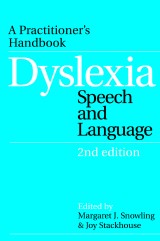Details

Dyslexia, Speech and Language
A Practitioner's HandbookDyslexia Series (Whurr) 2. Aufl.
|
41,99 € |
|
| Verlag: | Wiley |
| Format: | EPUB |
| Veröffentl.: | 21.05.2013 |
| ISBN/EAN: | 9781118687758 |
| Sprache: | englisch |
| Anzahl Seiten: | 376 |
DRM-geschütztes eBook, Sie benötigen z.B. Adobe Digital Editions und eine Adobe ID zum Lesen.
Beschreibungen
This authoritative handbook presents current ideas on the relationship between spoken and written language difficulties. It provides clinical and educational perspectives on the assessment and management of children's reading and spelling problems. The book begins with a theoretical overview. <p>The second edition continues the theme of linking theory and practice. It is aimed at practitioners in the fields of education, speech and language therapy, and psychology. All original chapters have been updated and new chapters are added to reflect current developments.</p>
Preface to the Second Edition. <p>Preface to the First Edition.</p> <p>Contributors.</p> <p>Chapter 1: Language skills and learning to read: the dyslexia spectrum (Margaret J. Snowling).</p> <p>Chapter 2: Speech and spelling difficulties: what to look for (Joy Stackhouse).</p> <p>Chapter 3: The dyslexic brain (W.A. Lishman).</p> <p>Chapter 4: The prediction and screening of children’s reading difficulties (Valerie Muter).</p> <p>Chapter 5: Assessing speech and language skills in the school-age child (Hilary Gardner).</p> <p>Chapter 6: Assessing reading and spelling skills (Nata K. Goulandris).</p> <p>Chapter 7: Assessing children’s reading comprehension (Kate Nation).</p> <p>Chapter 8: Short-term memory: assessment and intervention (Maggie Vance and Jane E. Mitchell).</p> <p>Chapter 9: Phonological awareness and reading intervention (Peter J. Hatcher).</p> <p>Chapter 10: Spelling: challenges and strategies for the dyslexic learner and the teacher (Claire Jamieson and Sarah Simpson).</p> <p>Chapter 11: Developing handwriting skills (Jane Taylor).</p> <p>Chapter 12: Managing the needs of pupils with dyslexia in mainstream classrooms (Janet Hatcher).</p> <p>Chapter 13: The assessment and management of psychosocial aspects of reading and language impairments (Poppy Nash).</p> <p>Chapter 14: Supporting language and literacy in the early years: interdisciplinary training (Jannet A. Wright and Janet Wood).</p> <p>Chapter 15: Current themes and future directions (Maggie Snowling and Joy Stackhouse).</p> <p>References.</p> <p>Author index.</p> <p>Subject index.</p>
<p>"... the second edition offers sufficient new and updated information to make its purchase worthwhile." (<i>Dyslexia Review</i>, September 2006)</p>
<p>Edited by <strong>Margaret Snowling</strong>, University of York, UK. <p>Edited by <strong>Joy Stackhouse</strong>, University of Sheffield, UK.
<b>"About 10% of the population have some form of dyslexia. About 4% are severely dyslexic, including some 375,000 schoolchildren."<br /> —The Dyslexia Institute, UK</b> <p>The first edition of <i>Dyslexia, Speech and Language</i> explored the relationship between spoken and written language difficulties, and so provided useful educational and clinical perspectives on children’s reading and spelling problems. The second edition continues to link theory with practice and will be of great value to professionals in the fields of education, speech and language therapy and psychology. All the original chapters have been updated, and new authors have been included to cover current developments.</p> <p>The first part of the book focuses on the nature of spoken and written language difficulties. It includes chapters on the dyslexic brain; speech, phonological awareness and spelling problems; and the predictors of literacy difficulties.</p> <p>The second part moves on to the assessment of reading, spelling, speech and language difficulties. To manage these difficulties, the book covers new approaches to reading intervention, teaching spelling and handwriting skills, and techniques for training memory. Importantly, it also considers how to deal with the needs of people with dyslexia in a mainstream setting.</p> <p>Finally, the book concludes with chapters on the psychosocial needs of children with language learning difficulties and on the interdisciplinary training of early years’ workers followed by a discussion of future directions for research and practice.</p>

















